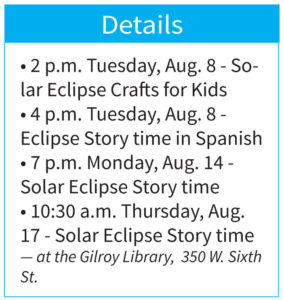The Bigger Picture … with Marty Cheek: Solar eclipse can get youngsters curious about planets, science
Published in the August 9 – August 22, 2017 issue of Gilroy Life
By Marty Cheek

Marty Cheek
 The shadow of the moon will travel across much of America Monday, Aug. 21, and the folks at the Gilroy Library are excited about this special celestial event. The “Great American Solar Eclipse” is the first time in 38 years that a total solar eclipse will be visible in the continental United States.
The shadow of the moon will travel across much of America Monday, Aug. 21, and the folks at the Gilroy Library are excited about this special celestial event. The “Great American Solar Eclipse” is the first time in 38 years that a total solar eclipse will be visible in the continental United States.
People in latitudes north of us in 14 states (starting at 10:15 a.m. on Oregon’s Pacific coast) will get the chance to see the full eclipse obscuration, the point when the moon completely covers the sun, creating the illusion of a burning black ring in the sky. We in Santa Clara County have the opportunity to experience a partial eclipse with a 60 percent darkening of the sun. It won’t be as dramatic as a total eclipse, but trust me, it will still be something worth watching.
Kelly B. Young, the supervising librarian for adult and teen services at the Gilroy Library, told me in an email recently that to celebrate this rare celestial wonder the library will host a public viewing party outside on the paseo.
If you and your kids really want to geek out and get deep into the science of eclipse phenomena, the library has two special public events. At 7 p.m. Aug. 8, it will hold a Solar Eclipse Seminar where Dr. Andrew Van Tuyl, a meteorology instructor, will share his astronomical knowledge. At 7 p.m. Aug. 16, the public is welcome to hear Elizabeth Keller, a NASA senior scientist, share the story about what causes an eclipse and why the one Aug. 21 is going to wow the world.
No doubt the Great American Solar Eclipse will be an occasion kids will remember for the rest of their lives. There’s much more to astronomy than a big shadow of the moon crossing over us here down on Earth, however, so I encourage you to continue the learning after it’s over. Use the eclipse to get your children and young people you know jazzed about the science of astronomy. And our public libraries are an excellent resource for families to gain greater knowledge that comes from sky gazing.
The Santa Clara County Library System has many excellent books and videos for children and adults that can take you via a mental “spaceship” on voyages to the other planets that neighbor Earth. The Internet also contains video and text content appropriate for young people to “explore” Mercury, Venus, Mars, the asteroid belt, Jupiter, Saturn, Uranus, Neptune, the Kuiper Belt and the Oort Cloud — as well as the diverse variety of moons orbiting the planets. And maybe after wading through the local solar system, young people will want to voyage out to the rest of the Milky Way Galaxy and learn about the stars and black holes. Also helpful to learn about the sky are special apps on smart phones that enable users to point these digital devices upward and see displayed on the screen where the stars and planets are located at any given time.
Astronomy for many people has been a gateway to learning about the other various sciences. Maybe from an introduction to astronomy your kids might wish to better understand how the sun produces its heat and light. That’s a great way to help them learn about the physics involved in fusion, the process of converting hydrogen atoms into helium through the immense heat and pressure at the heart of the sun.
Astronomy is also a way to consider how far humans have come in our understanding of the universe. People of earlier ages, including the native Indians who made their homes for thousands of years in the South Valley region, did not have the entertainment of TV or films. So at night they engaged in sky-watching, gazing at the starry vault overhead and wondering what those points of light might be. Many cultures even named the stars and grouped them into constellations and made up stories about their origin.
Today, humans send space probes to worlds as far away as the dwarf planet Pluto and view the detailed photos radioed back to Earth that make those places more than merely mysterious points of light in the black of space. They are spheres of wonder that maybe in a century or two humans might travel to and live on science bases. That’s something to chat with your kids about and get them excited about the adventure of scientific discovery.
I encourage you to safely view with special glasses the upcoming solar eclipse. This event will bring many of us Americans together to experience the awe of our solar system. It can instill in us a sense of humility by understanding we humans are truly tiny in the universe. It will also help us to understand how our lives on this pale blue dot, this special place we call home, is shaped by the energy and gravity of the sun and moon.[/et_pb_text] [/et_pb_column] [/et_pb_row] [/et_pb_section]
